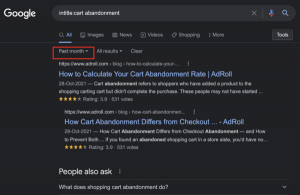Trade shows are really a fantastic way to build awareness of your products and are indispensable when your product benefits from the face-to-face interaction possible only through a trade show. CES, the granddaddy of all consumer electronics shows, for instance, is a great place to introduce your new gadget. Not only do trade shows offer opportunities for prospective buyers to give your new product a test drive, but the press amplifies your message when they cover the event. Done right, even regular attendees share your product through their personal social media, blogs, and videos, thus reaching vastly more people than actually attended the event.
Why attend trade shows
Advantages of trade shows
As you can see from the size of the crowd at a recent CES trade show (in the image above), trade shows are a brilliant way to gain a lot of exposure. But, even more important, attendees self-select trade shows, which often involve an expense to keep out the merely curious or those will only a passing interest in products like yours. This selection means that attendees represent two important criteria necessary for conversion; namely, they have interest and desire and may also possess the other two criteria for conversion, authority and money. This makes trade shows a target-rich event where you can close deals with individuals or, even better, with retail partners who will widely distribute your products. You have opportunities to sell directly to customers at the trade show but the real bonus from attending trade shows comes through future sales to both individuals who learn about your brand when a connection shares a positive attitude toward your product either virtually or face-to-face and through sales to retailers who attend the event. Thus, sales from the trade show are difficult to predict, especially if you’re new to the trade show game.
Here are some aspects to consider when forecasting revenue from a trade show:
- the number of visitors to your booth
- # of VIPs, stakeholders, existing customers, and warm leads engaged
- number of converted leads
- win rate percentage
- average time to close a deal after the show
- new customer lifetime value
- uptake of an exclusive event promotion
Disadvantages of trade shows
With all these advantages, trade shows offer a number of challenges; challenges you must overcome to recoup the often high expense involved in attending a trade show. Check out the image below to see all that goes into calculating the ROI of trade shows; you must consider the following costs:
- travel for folks setting up and manning the booth
- electricity, since most trade shows don’t supply power so you must hire someone to install electricity and pay for it
- booth, as you likely want something distinctive to showcase your products
- banners and signage
- products to demonstrate
- swag
- transportation to and from the event
- and, in an effort to attract attention, some vendors may use celebrities, robots, simulators, working models of their product, or other gimmicks designed to draw attention to their product
In addition to the cost of attending a trade show, the problem with trade shows is that there are always competitors and it’s easy to find yourself struggling to gain attention, especially if you’re the new kid on the block with a limited budget.
 Image courtesy of Ten Pound Hammer
Image courtesy of Ten Pound Hammer
Gaining attention at trade shows
Thus, your ROI depends on your ability to attract attention from those attending the trade show. As you see in the image showing the typical CES trade show, booths are set up one after another in long rows that fill an entire massive building, sometimes spilling onto additional floors. For instance, the new car show in DC fills nearly the entire convention center, which is actually two buildings with a road pedestrians must cross to get to the other side. Thus, location is a critical factor in getting visitors to your booth. Negotiating a favorable location is the first step toward attaining visitors during the event.
But, there are many other actions that influence the number of visitors you get, which impacts your success and ROI. Carefully planning helps ensure you don’t waste time and money without getting sufficient returns. Here are some things to consider when choosing a trade show strategy.
Start before you get there
In the weeks that lead to your event, careful preparation spells either success or disaster. Consider everything you’ll need for the trade show and allow sufficient time for producing the items you need. Consider shipping them directly to the venue, as shipping costs money, and shipping twice is sometimes wasteful.
Here are items you must order early in the planning process:
- Swag. Everyone expects to get goodies at the event. You need to hand out things such as pencils, t-shirts, or pens, although handing out some unique swag helps you stand out from the crowd. If you have a highly coveted piece of swag, you’ll have attendees standing around hoping to score something.
- Signs for your event. You’ll need signs and a banner or two to identify your company and display images of your product. Ensure the signs contain a hashtag for the event to help measure the success of your social strategy.
- Electricity
- A booth, unless you have a traveling booth and chairs you already use.
- Prizes. Companies commonly offer prizes as a way to entice attendees to drop a business card or fill out an entry form. This information then goes into a lead nurturing program.
- Arrange travel and outside events such as dinners at local places of interest, such as museums, theaters, etc.
Try to look professional, but fun and ensure everything supports your brand with logos, hashtags, and contact information. If possible, link your swag and booth setup to your product. Brochures often end up in the trash, so, whenever possible, include key take-aways from the brochure on your swag, which most will take back to their homes and businesses.
Create a buzz
Remember that buzz is all about a conversation.
- Before you leave, set up your social media and blogging campaigns to announce your attendance at the trade show and build excitement among those attending.
- Send press releases to local media, as well as media in your industry and those in the area around the venue.
- Advertise in the brochure and press releases organized by the trade show organization to publicize your attendance.
- In some cases, organizers provide lists of those pre-registered for the show. Use this list to find your best prospects and invite them to special events outside the venue, such as private dinners.
Spark interaction
Your booth is your stage and you must own it. Never sit behind the booth waiting for someone to ask a question. Be proactive, like a carnival barker, to entice those passing your booth to stop and interact with you. Some businesses use candy to entice passers-by, while others organize games or contests to entertain those passing the booth and entice them to stop for a while.
Ensure you have sufficient staff on hand to answer questions, as well as run games or simulations. You might even use staff in costumes or branded apparel to wander through the hall and entice attendees into a conversation.
Plan for your next event
Do your research and check out the big dogs in the industry. When you do this, you learn what they bring to the event. Make note of the staff they are bringing with them and how attendees respond to their efforts. If you see a large crowd around a specific booth, note elements attracting the attention. Also, scope out the swag you see attendees carrying. Often, there’s a lot of competition to hand out the best swag since attendees only have a limited ability and interest in carrying stuff around. Incorporate this knowledge into your next trade show planning.
Hand out reusable bags
Every company hands stuff out at the trade show and attendees need bags to hold their loot. Not only do bags offer something valuable to attendees, but they’re also very visible as the bags move through the venue. Even heading home, the bags display your brand.
Business & Finance Articles on Business 2 Community
(20)




